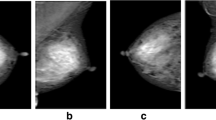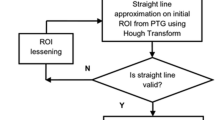Abstract
Accurate segregation of pectoral muscles is very crucial in breast cancer detection. Pectoral segmentation is a challenging task due to heterogeneous tissues densities, neighborhood complexities and breast shape variabilities. This paper presents an adaptive gamma correction method for pectoral suppression in mammograms. The proposed algorithm is adaptive to variations in shape, density of tissues and the curvature of pectoral boundary i.e. straight line or curved pectoral boundary. The method utilizes the morphological information of mammograms to discriminate the breast parenchyma from the rest of breast region. The adaptive gamma corrections enhance the mammograms according to tissues densities and provide a separation boundary between breast region and pectoral parenchymal. The method is tested on three types of tissues densities present in MIAS dataset i.e. Fatty, Fatty-glandular and Dense tissues. The goodness of segmentation is measured using jaccard similarity index between the ground truth and segmented regions. The proposed methods successfully detected 98.45 % of the pectoral regions and have an overall 92.79 % jaccard similarity index with the ground truth. Moreover, evaluation by experts also confirms good performance of the proposed method.







Similar content being viewed by others
Notes
Virginie Briantais, Jean Villar Clinic, 33520 Bruges, France.
Fakhreddine Ababsa, Evry University, 91020 Evry, France
References
Birdwell RL, Bandodkar P, Ikeda DM (2005) Computer-aided detection with screening mammography in a university hospital setting 1. Radiology 236(2):451–457
Boyd N, Byng J, Jong R, Fishell E, Little L, Miller A, Lockwood G, Tritchler D, Yaffe MJ (1995) Quantitative classification of mammographic densities and breast cancer risk: results from the canadian national breast screening study. J Nat Cancer Inst 87(9):670–675
Camilus KS, Govindan V, Sathidevi P (2010) Computer-aided identification of the pectoral muscle in digitized mammograms. J Digit Imag 23(5):562–580
Ciatto S, Del Turco MR, Risso G, Catarzi S, Bonardi R, Viterbo V, Gnutti P, Guglielmoni B, Pinelli L, Pandiscia A et al (2003) Comparison of standard reading and computer aided detection (cad) on a national proficiency test of screening mammography. Eur J Radiol 45(2):135–138
Dense B, Dense C (2013) Autodensity: an automated method to measure mammographic breast density that predicts breast cancer risk and screening outcomes
Doi K (2007) Computer-aided diagnosis in medical imaging: historical review, current status and future potential. Comput Med Imag Graph 31(4):198–211
Duarte M, Alvarenga A, Azevedo C, Infantosi A, Pereira W (2012) Estimating the pectoral muscle and the nipple positions in mammographies using morphological filters. In: XXIII Congresso Brasileiro em Engenharia Biomédica, vol 52
El-Zaart A (2010) Expectation–maximization technique for fibro-glandular discs detection in mammography images. Comput Biol Med 40(4):392–401
Fenton JJ, Taplin SH, Carney PA, Abraham L, Sickles EA, D’Orsi C, Berns EA, Cutter G, Hendrick RE, Barlow WE et al (2007) Influence of computer-aided detection on performance of screening mammography. New England J Med 356(14):1399–1409
Galdran A, Picón A, Garrote E, Pardo D (2015) Pectoral muscle segmentation in mammograms based on cartoon-texture decomposition. In: Pattern recognition and image analysis. Springer, pp 587–594
Ganesan K, Acharya UR, Chua KC, Min LC, Abraham KT (2013) Pectoral muscle segmentation: a review. Comput Methods Programs Biomed 110(1):48–57
Ge M, Mainprize JG, Mawdsley GE, Yaffe MJ (2014) Segmenting pectoralis muscle on digital mammograms by a markov random field-maximum a posteriori model. J Med Imag 1(3):034,503–034,503
Hacking D, Pacifci S Craniocaudal view. https://radiopaedia.org/articles/craniocaudal-view. Accession date 15.11.2016
Hacking D, Pacifci S Mediolateral view. https://radiopaedia.org/articles/mediolateral-oblique-view. Accession date 15.11.2016
He W, Juette A, Denton ER, Oliver A, Martí R, Zwiggelaar R (2015) A review on automatic mammographic density and parenchymal segmentation. Int J Breast Cancer
Keller B, Nathan D, Wang Y, Zheng Y, Gee J, Conant E, Kontos D (2011) Adaptive multi-cluster fuzzy c-means segmentation of breast parenchymal tissue in digital mammography. In: International conference on medical image computing and computer-assisted intervention. Springer, pp 562–569
Kwok SM, Chandrasekhar R, Attikiouzel Y, Rickard M T (2004) Automatic pectoral muscle segmentation on mediolateral oblique view mammograms. IEEE Trans Med Imag 23(9):1129–1140
Li Y, Chen H, Yang Y, Yang N (2013) Pectoral muscle segmentation in mammograms based on homogenous texture and intensity deviation. Pattern Recogn 46(3):681–691
Liberman L, Menell JH (2002) Breast imaging reporting and data system (bi-rads). Radiol Clin North Amer 40(3):409–430
Lu LJW, Nishino TK, Khamapirad T, Grady JJ, Leonard MH, Brunder DG (2007) Computing mammographic density from a multiple regression model constructed with image-acquisition parameters from a full-field digital mammographic unit. Phys Med Biol 52(16):4905
Matsubara T, Yamazaki D, Kato M, Hara T, Fujita H, Iwase T, Endo T (2001) An automated classification scheme for mammograms based on amount and distribution of fibroglandular breast tissue density. In: International congress series, vol 1230. Elsevier, pp 545–552
Mustra M, Grgic M (2013) Robust automatic breast and pectoral muscle segmentation from scanned mammograms. Signal Process 93(10):2817–2827
Oliver A, Freixenet J, Marti R, Pont J, Perez E, Denton ER, Zwiggelaar R (2008) A novel breast tissue density classification methodology. IEEE Trans Inform Technol Biomed 12(1):55–65
Olsén C, Mukhdoomi A (2007) Automatic segmentation of fibroglandular tissue. In: Image analysis. Springer, pp 679–688
Raba D, Oliver A, Martí J, Peracaula M, Espunya J (2005) Breast segmentation with pectoral muscle suppression on digital mammograms. In: Iberian conference on pattern recognition and image analysis. Springer, pp 471–478
Society AC (2015) Global cancer facts & figures, 3rd edn. http://www.cancer.org/acs/groups/content/research/documents/document/acspc-044738.pdf
Sreedevi S, Sherly E (2015) A novel approach for removal of pectoral muscles in digital mammogram. Procedia Comput Sci 46:1724–1731
Suckling J, Parker J, Dance D, Astley S, Hutt I, Boggis C, Ricketts I, Stamatakis E, Cerneaz N, Kok S et al (1994) The mammographic image analysis society digital mammogram database. In: Exerpta Medica. International congress series, vol 1069, pp 375–378
Wirth MA (2006) Performance evaluation of cade algorithms in mammography. Recent Adv Breast Imag Mammograph Comput-Aided Diag Breast Cancer:640–671
Zhang Y, Wang S, Sun P, Phillips P (2015) Pathological brain detection based on wavelet entropy and hu moment invariants. Bio-Med Mater Eng 26(s1):S1283–S1290
Zhang YD, Wang SH, Liu G, Yang J (2016) Computer-aided diagnosis of abnormal breasts in mammogram images by weighted-type fractional fourier transform. Adv Mech Eng 8(2):1687814016634,243
Zhou C, Chan HP, Petrick N, Helvie MA, Goodsitt MM, Sahiner B, Hadjiiski LM (2001) Computerized image analysis: estimation of breast density on mammograms. Med Phys 28(6):1056–1069
Acknowledgments
The work is supported by URIF grant 0153AA-B52.
The authors are thankful to Virginie Briantais, Radiologist at Jean Villar Clinic, 33520 Bruges, France & Dr Fakhreddine Ababsa, image processing Expert, Evry University, 91020 Evry, France.
Author information
Authors and Affiliations
Corresponding author
Rights and permissions
About this article
Cite this article
Safdar Gardezi, S.J., Adjed, F., Faye, I. et al. Segmentation of pectoral muscle using the adaptive gamma corrections. Multimed Tools Appl 77, 3919–3940 (2018). https://doi.org/10.1007/s11042-016-4283-4
Received:
Revised:
Accepted:
Published:
Issue Date:
DOI: https://doi.org/10.1007/s11042-016-4283-4




